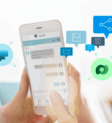How Are Chatbots Helping the Healthcare Industry Fight the COVID-19 Crisis

The ongoing COVID-19 pandemic has especially affected the healthcare industry enormously. Doctors and healthcare staff are working tirelessly to treat the growing number of patients at the hospitals.
A disturbing trend posing a severe threat to the general health and well-being of the society is the spike in the volume of fake news and misinformation regarding COVID-19. The subsequent increase in queries from the anxious public has overwhelmed the staff at the urgent care centers.
Thus, the sector is looking at digital platforms to help ease the pressure. AI-enabled chatbots, in particular, are one technology that can infuse agility in healthcare operations and are fundamental to adopt as the healthcare industry makes its transition to recovery.
Chatbots can assist people with an initial screening of symptoms, thus limiting any avoidable visits to the doctors. Additionally, this prevents the spread of the virus by curbing the inflow of people into hospitals.
Chatbots can handle an unlimited number of conversations and requests simultaneously with lower operational costs. As hospitals function with infrastructure constraints, deploying chatbots can help them manage patients effectively with limited resources.
How can chatbots help the healthcare sector amidst the crisis?
1. Limiting doctor visits with pre-screening and self-treatment
In a study published in JAMIA, researchers from the Indiana University Kelley School of Business conducted an online experiment with participants who viewed a COVID-19 screening session between a hotline agent – either human or chatbot – and a user with COVID-19 symptoms.
The research concluded, “The primary factor driving user response is perception of the agent’s ability. When ability is the same, users view chatbots no differently or more positively than human agents.”
Every hospital and quarantine facility in the world is functioning off limited resources, including insufficient beds, ventilators, protective suits, masks, etc. To reduce the burden on the healthcare staff, the need of the hour is self-diagnosis and treatment using chatbots.
And how is this done? In case a person is experiencing flu-like symptoms such as a headache or mild fever, he may consult the chatbot for at-home pre-screening. The virtual assistant asks questions such as – age, initial symptoms, travel history, existing ailments, etc. – to map answers with the possible symptoms of COVID-19.
In case the symptoms don’t match with the warning signs of the disease, the chatbot advises the user on the next set of steps to be taken, which may be simple preventive measures. If the patient needs further observation, the chatbot can recommend a visit to the doctor.
Additionally by staying at home, chatbot users can prevent the spread of their disease. And also may protect themselves from catching another infection by visiting the hospital.
2. Scheduling Virtual And Physical Appointments
Chatbots can offer services such as locating nearby healthcare facilities, scheduling virtual and physical appointments, and encouraging users to participate in clinical trials.
As seen above, depending on the severity of the symptoms, a chatbot may recognize the need for a doctor’s appointment. In case of mild symptoms, the chatbot may connect the user virtually to an available medical professional.
However, if the symptoms necessitate a physical consultation, or if the patient requests for one, the chatbot can quickly draw up information from a database of hospitals and book the next available slot for the appointment.
3. Providing the right information
The need to deliver the right information and fight the spread of fake news has never been more critical. To reduce the panic around the pandemic, it is imperative that people have access to the most authentic information.
Chatbots can be designed to answer frequently asked queries around the pandemic and be constantly updated with the latest information from authentic healthcare sources. Moreover healthcare chatbots can provide users with diverse and personalized sources related to mental health, monitoring health and wellness, and self care.
So, the next time someone wants answers to “Can the coronavirus spread through air?”, “What are the common symptoms of COVID-19?”, “How to boost my immune system?”, they should look no further than a simple chatbot that is designed to disseminate the facts on all such queries.
This not only reduces panic among patients but also reduces the burden on healthcare staff and drives patient engagement.
Hospital systems can also deploy chatbots to provide general information about their operations and services e.g medical tests timings, working hours of doctors, availability of medical equipment etc.
A Quick Glance at the Existing COVID-19 Healthcare Chatbots
- Providence St. Joseph Health is a Catholic healthcare system based in a Seattle suburb and serves patients in six western states in the U.S. The organization created a new version of its existing chatbot Grace, using Microsoft Healthbot and Azure services, to answer questions and guide the users to the next steps upon analysing whether they are at a risk of having a coronavirus infection.
- Users can get information without calling physicians or showing up at the ER office. If the patients need further care, they are sent to Providence Express Care Virtual Visits or other clinically appropriate follow-up.
- As per the stats in March 2020, more than 150,000 messages per day were exchanged between the bot and the patient. The bot engagement rate on the COVID-19 advisory page (i.e. percentage of people who land on the advisory page and click on the bot) was on average over 20%.
- The Montefiore Health System located in New York, the biggest hotspot for coronavirus, experienced a large volume of calls coming into the doctors’ offices, a rapid surge in demand for services, and anxious patients flooding the ER.
- To address this issue, Montefiore developed and deployed a COVID-19 symptoms screening tool and chat solution on its website to provide COVID-19 information and pre-screen services to the users. Additionally, the chatbot can direct users to important website pages such as the FAQ page and the patient portal application. During the first week of deployment itself, the organization witnessed hundreds of daily conversations with the chatbot.
We, at Acuvate Software, are proactively helping healthcare organizations tide over the challenges created by the pandemic, through our intuitive, no-code bot-builder platform called BotCore.
BotCore presents several advantages –
- the intuitive, no-code interface allows quick development and implementation of chatbot technology;
- it can seamlessly integrate with existing legacy systems and AI services;
- it is versatile, as it can be deployed on both on-site and cloud environments;
- Chatbots can be trained to simulate highly complex conversations.
To conclude…
The COVID-19 pandemic has presented a sea of challenges for the healthcare sector.
The pressure on the healthcare staff is mounting, as they scramble to meet the growing healthcare needs with insufficient resources. As telehealth and self care procedures become more common, for many healthcare systems, chatbots are becoming the core of their digital transformation journeys. Deploying chatbots during this crisis is key to drive patient engagement, streamline customer support operations, reduce panic, deliver services efficiently and reduce the overall burden on healthcare systems.
If you’d like to learn more about this topic, please feel free to get in touch with one of our healthcare and chatbot experts for a personalized consultation.
Further Insights:
Rakesh Reddy is our co-founder and a serial entrepreneur. A mechanical engineer by education, his business vision and direction as Chairman & CEO drives us to excellence. An avid team player, he works with his executive team to trigger growth for Acuvate across geographies and business areas. His business acumen, strategy and planning skills catalyzed the growth of Acuvate since its inception. A natural leader, he has been able to successfully bootstrap his companies, help win customers and successfully constitute the company’s board and a robust leadership team.






Rakesh Reddy